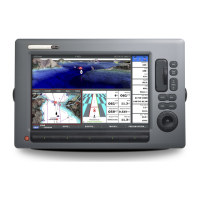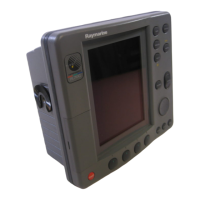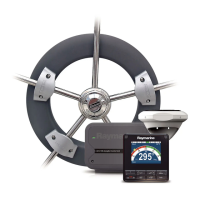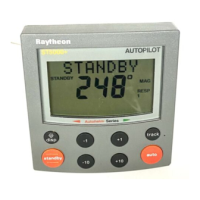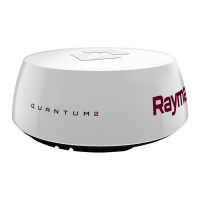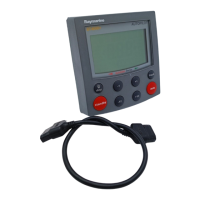Aligningcompassmanually
WherenoGPSispresentmanualalignmentofthecompass
isrequired.
1.ContinuetosteeronasteadycourseandusetheUse+1and
-1buttons,ortheROTARYcontrollertoadjusttheheading
displayeduntilitmatchesthevessel’scompassreading.
2.WhencompletepressCONTINUEtobeginAutolearn.
AutoLearn
Youmusthavesignicantclearwaterinfrontofthevesselto
accommodateaseriesofmaneuvers,whichincludesudden,
sharpturns.Thereshouldbeaclearareaatleast100mwide
and500mahead.
Caution:Autolearn
Pleaseensuresufcientfreespaceahead.
(Minimum100x500mlong&signicantlymorefora
highspeedvessel.
PerformingAutolearn
AutolearnisavailablefromtheSeatrialwizard,orfromthe
Commissioningmenu.
Maintainanormalcruisingspeed(atleast3kts)throughoutthe
autolearnprocess.
1.Ensurethereissufcientfreewaterinfrontofthevesseland
selectcontinue.
Awarningmessageisdisplayed.
2.SelectContinueorpresstheOkbutton.
Awarningmessagewillbedisplayedlettingyouknowthat
thevesselwillzigzagandmakeSuddenSHARPTURNS.
3.RemoveyourhandsfromthewheelandpressAutotobegin.
Duringthisproceduretheautopilotwillprogressthroughthe
requiredsteps.
4.If‘PASS’isdisplayedthenselectContinueorpresstheOk
buttontoreturntomanualhelmcontrol.
TheautopilotwillbyplacedinStandbymode.Youhave
successfullycompletedthecommissioningprocessforyour
SmartPilotsystem.
5.If‘FAIL’isdisplayedaftercompletionoftheAutolearn
processthenselectContinueorpresstheOkbutton.
TheAutolearnretrymessageisdisplayed.
6.YoucanretrytheAutolearnprocessbyselectingYesorto
cancelselectNo.
Note:TheSeatrialwizardcanbecancelledatanytimeby
pressingtheStandbybutton.
Caution:Systemchanges
Anyadditionalchangesyoumaketoyoursystem
settingsmayrequireyoutorepeatthecalibration
process.
8.10Checkingautopilotoperation
Aftercompletingcalibration,checkthebasicautopilotoperation,
asfollows:
1.Steerontoacompassheadingandholdasteadycourse
atnormalcruisingspeed.Ifnecessary,steerthevessel
manuallyforashorttimetocheckhowthevesselsteers.
2.Ensureitissafetoengagetheautopilot,thenpressAUTOto
lockontothecurrentheading.Theautopilotshouldholda
constantheadingincalmseaconditions.
3.Use-1,+1,-10and+10ortheROTARYcontroller,tosee
howtheSmartPilotaltersthecoursetoportandstarboard.
4.PressSTANDBYtoreturntomanualsteering.
Checkingruddergain
Todeterminewhethertheruddergainissetcorrectly,carryout
thefollowingtest:
ItemDescription
1.Ruddergaintoolow
2.RuddergaintooHigh
3.
Correctruddergain
1.Ensureyouhavesettheautopilotresponsetolevel5.
2.Driveyourvesselatatypicalcruisingspeedinclearwater.
Itiseasiertorecognizethesteeringresponseincalm
seaconditionswherewaveactiondoesnotmasksteering
performance.
3.PressAUTOtoenterAutomode,thenaltercourseby40°:
•Thiscoursechangeshouldresultinacrispturnfollowed
byanovershootofnomorethan5°,Iftheruddergainis
adjustedcorrectly.
•Ifthecoursechangecausesadistinctovershoot(more
than5°)and/orthereisadistinct‘S’inthecoursethe
ruddergainistoohigh.
•Ifthevessel’sperformanceissluggishandittakesalong
timetomakethe40°turn,withnoovershoottherudder
gainistoolow.
Ifnecessary,adjusttheruddergain.
Checkingcounterrudder
Counterrudderistheamountofrudderyourautopilotapplies
totrytopreventyourvesselfromveeringoffcourse.Higher
counterruddersettingsresultinmorerudderbeingapplied.
Tocheckthecounterruddersetting:
1.Ensureyouhavesettheautopilotresponsetolevel5.
2.Driveyourvesselatatypicalcruisingspeedinclearwater.
3.PressAUTOtoswitchtheautopilottoAutomode,thenmake
a90°coursechange:
•Whenruddergainandcounterrudderarebothset
correctly,thevesselperformsasmoothcontinuousturn
withminimalovershoot.
•Ifthecounterrudderistoolow,thevesselwillstill
overshoot.
•Ifcounterrudderistoohigh,thevesselwill‘ght’theturn
andmakeaseriesofshort,sharpturns.Thisresultsina
very‘mechanical’feelasthevesselchangescourse.
Commissioning-SPXandSmartPilotsystems
51

